Creating an affiliate marketing website is a key step to building a sustainable income stream in the online marketing space. It serves as the foundation for promoting affiliate products, driving traffic, and earning commissions. Whether you’re new to affiliate marketing or looking to establish a professional platform, this guide will walk you through the entire process.
Quick Summary
Here’s a quick breakdown of the steps to create an affiliate marketing website:
– Understand what an affiliate marketing website is and how it works.
– Choose a niche and define your target audience.
– Set up your website by selecting a domain, hosting, and platform.
– Design the site with a professional theme and essential pages.
– Create quality content that promotes affiliate products effectively.
– Drive traffic using SEO, social media, and email marketing.
– Track performance and optimize your site for better results.
Let’s dive into each step in detail.
What is an Affiliate Marketing Website?
An affiliate marketing website is a platform that promotes products or services in exchange for a commission. The website owner earns money whenever a visitor clicks on an affiliate link and completes a specific action, such as purchasing a product.
How it works:
1. The affiliate joins an affiliate program and receives unique links to promote.
2. They publish content, such as reviews or guides, featuring these links.
3. Visitors click the links and are redirected to the merchant’s site.
4. The affiliate earns a commission if the visitor converts (e.g., makes a purchase).
Building a well-designed affiliate marketing website helps establish trust, attract visitors, and maximize conversions.
Choosing Your Niche
Why a niche matters:
A niche defines the focus of your website and ensures your content appeals to a specific audience. Choosing the right niche is critical for standing out in a competitive market.
Tips for Choosing a Niche
– Follow your interests: Select a topic you are passionate about to maintain long-term motivation.
– Evaluate profitability: Research affiliate programs to ensure the niche has products with good commission rates.
– Analyze competition: Choose a niche with demand but not overwhelming competition.
– Personal experience: Do you have the relevant knowledge, skills and expertise of a given field. Then start creating content around your expertise.
Note: If you have already chosen your niche you can scroll down to the next step and start creating your affiliate website.
Example Niches
| Niche | Potential Products to Promote |
| Fitness | Supplements, workout equipment, Healthy Meal Plans |
| Technology | Software and SaaS Products, Tech gadgets and Devices, Artificial Intelligence and Machine Learning, Web Hosting & Domain Services etc. |
| Gaming | Gaming consoles, Accessories, Events |
| Home Improvement | Tools, furniture |
| Personal Development | Online courses, Coaching services, Books & eBooks, Workshops etc. |
Defining Your Target Audience
Once you have a niche, identify who your website will serve. Understanding your audience ensures your content aligns with their needs and interests.
How to define your audience:
– Research their demographics (age, gender, location).
– Understand their challenges and preferences.
– Use tools like Google Trends or forums to analyze common questions and trends in your niche.
Setting Up Your Website
Selecting a Domain Name
A domain name is the website’s address (URL name) you will be using for your website. Your domain name should not be too difficult and complex to type. Choose something relevant, memorable, and easy to spell (e.g., tajedo.com). You can even use your own name as your domain name.
Tips:
– Include your niche keywords if possible.
– Keep it short and avoid numbers or special characters.
– Use tools like A2 hosting or Bluehost to check your domain name availability.
Get Started with Bluehost Today
Choosing a Hosting Provider
A hosting provider stores your website information and makes it accessible online.
A reliable hosting platform ensures good performance and uptime. It also provides security to your website and integrates with WordPress. WordPress is the most popular platform for creating affiliate websites. It’s free, customizable, and supports various plugins.
Recommended hosting providers:
– Bluehost: Affordable and beginner-friendly.
– A2hosting: Ideal for WordPress sites.
In this guide we are going to use Bluehost for setting up both your domain name and web hosting.
Now, If you are ready to launch your blog? Follow along with a step by step guide.
Set up the domain name and web hosting plan
1. Click here to go to Bluehost
Once on the page, click on the “Get Started” button

2. Select the plan you want to use for your blog, based on your budget. We highly recommend you to select the Basic plan.
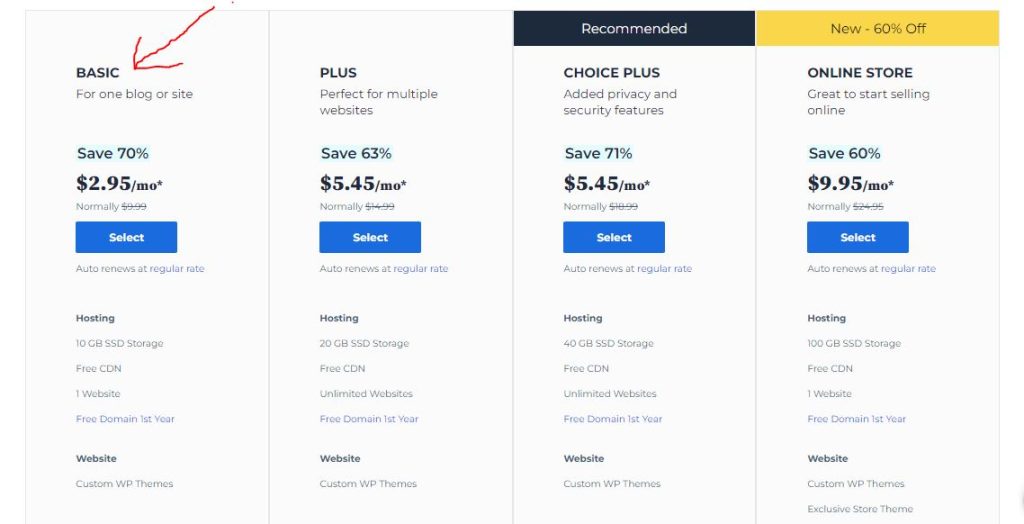
3. Enter the domain name you want to use (e.g., tajedo.com)
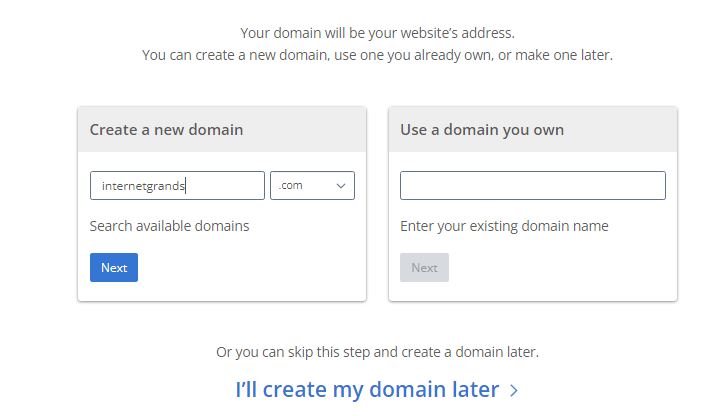
4. Enter your account information
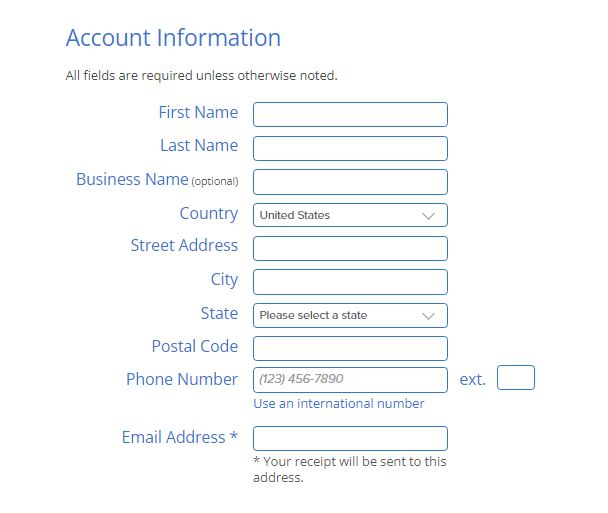
5. Under the package Information, choose an account plan based on how long you want to pay. Choose Basic plan 12/36 months. Remember there’s a 30 day money back guarantee with all plans, so no risk at all)
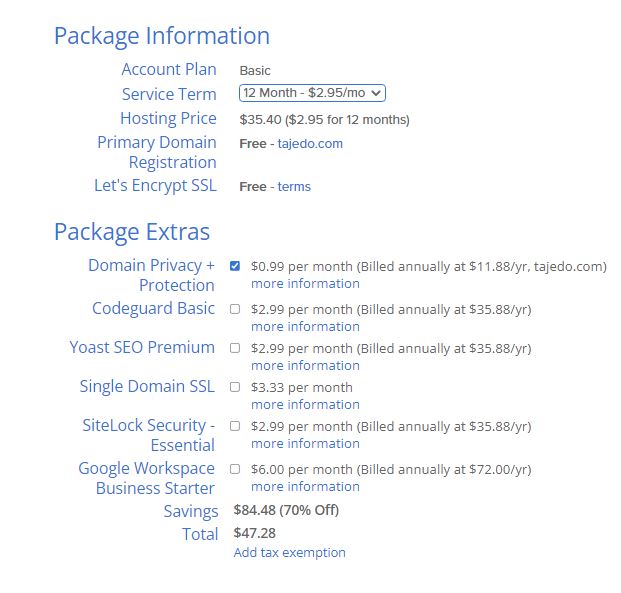
6. Uncheck the Extra package (you don’t really need them)
7. Enter your payment information to complete your purchase.
Once done here, a welcome email will be sent to your email inbox. Set your password and login to your Bluehost account.
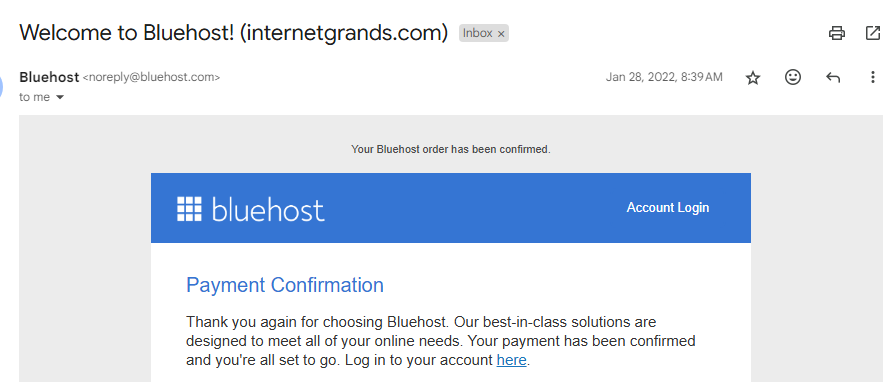
8. Skip the on-boarding questions, but choose a blog when prompted.
9. Click “Skip this Step” when it comes to choosing your theme (We shall get that done later in this guide)
Get Started with Bluehost Today
Installing WordPress
From the Bluehost dashboard, click the “Start Building” button to install WordPress.
Bluehost is a self hosted WordPress blog platform. It automatically installs WordPress in one click right from your hosting dashboard.
Steps to install WordPress:
1. Sign in to your hosting account.
2. Locate the WordPress installer and follow the prompts.
3. Log in to your WordPress dashboard to start building your site.
Pro Tip: You can ask the Tech Support to install it for you, if you have trouble installing it yourself.
Designing Your Website
Choosing a Theme
Select a clean, responsive theme that works well on mobile devices.
Popular themes:
– GeneratePress: Lightweight and customizable.
– Astra: Fast-loading and beginner-friendly.
Choose any of the two themes above.
Creating Essential Pages
Every affiliate marketing website should have these key pages:
– Homepage: Introduces your site and highlights your niche.
– About Page: Builds trust by sharing your story and mission.
– Contact Page: Provides a way for visitors to reach you.
– Blog page: Every blog has a “/blog” page. To add a new blog post on the admin sidebar, select “Post ” then “new post”
Legal pages: Ensures legal compliance for affiliate marketing. These include pages like Privacy Policy and Terms of Service.
Install the appropriate WordPress plugins
With an affiliate blog, it’s essential to choose the best plugins for SEO and site speed. Here are the appropriate plugins you should install.
Wpforms: This is one of the best plugins to add forms on your WordPress blog. Forms enable visitors to subscribe to your services or get in touch with you.
Yoast SEO: Highly recommended. This Plugin will help you manage your sitemap, robots.txt, page title & Meta descriptions. It also enables you to index web pages on the Google search console.
Wordfence: This Plugin protects a WordPress site from malware, spam and brute force attacks.
Wp Rocket: All in one WordPress performance plugin that cleans your database, compresses your large images, and caches your site. It keeps your site fast.
Updraftplus: a powerful plugin that allows you to manage and backup your WordPress site.
MonsterInsights: Best plugin to use if you want to connect your website to Google analytics.
Here is how to Install a new plugin on WordPress.
In the left menu, Select “Plugins” and then Click “Add New”. You can choose from the options available or search for the one that you want. Then Select “Install now” then click “Activate”. Done.
Note: The more plugins you have installed, the more chances of your site slowing down.
Get Started with Bluehost Today
Customizing Your Site
Add branding elements like a logo, adjust the navigation menu, and structure your site for user-friendliness.
Creating Quality Content for Your Affiliate Marketing Website
Content is the heart of an affiliate marketing website. High-quality content attracts visitors, builds trust, and persuades them to click on affiliate links. Without valuable content, your audience won’t stay engaged, and conversions will be low.
Types of Content for Affiliate Marketing
1. Product Reviews
Product reviews are one of the most effective types of content. They allow you to give honest feedback and highlight the benefits of a product, encouraging visitors to make a purchase through your affiliate link.
Tips for writing reviews:
– Focus on the features, benefits, pros, and cons.
– Share your personal experience or use cases.
– Be transparent about your affiliate relationship (this builds trust).
Example: Rankability Review (2025): Honest Look at Features & Pricing
2. How-To Guides and Tutorials
Providing step-by-step instructions or tutorials helps solve problems for your audience. These types of posts build authority and can link naturally to affiliate products that are part of the solution.
Example: “How to Create your own affiliate program from scratch”
3. Comparison Articles
Comparing similar products helps readers make decisions by highlighting the strengths and weaknesses of each option. Comparison articles often convert well because they directly address readers’ purchasing decisions.
Example: Trackdesk vs Rewardful: Which Affiliate Software is better for you?
4. Listicles & Alternative Posts
Create a blog post mentioning various tools with detailed explanation of what it is, key features and pricing.
Example:
5. Resource Pages
A resource page compiles useful tools, products, and services related to your niche. These pages act as a one-stop shop for your audience to find solutions, making them more likely to click on your affiliate links.
Incorporating Affiliate Links Naturally
While it’s important to add affiliate links to your content, you don’t want to come off as overly promotional. The key is to integrate them naturally within your content, offering value to the reader.
Tips for adding affiliate links:
– Context is key: Only link to products that genuinely help your audience.
– Use compelling calls-to-action (CTAs): Encourage your readers to click on links with phrases like “Check out this product for the best deal” or “See how this can help you achieve X.”
– Disclose affiliate relationships: Be transparent and follow legal guidelines by clearly stating that you may earn a commission if someone purchases through your link.
Driving Traffic to Your Affiliate Marketing Website
Once your website is set up and filled with valuable content, it’s time to attract visitors. Without traffic, no one will click on your affiliate links. Here are some strategies to drive traffic to your affiliate marketing website:
Search Engine Optimization (SEO)
SEO is crucial for getting organic traffic from search engines like Google. When you rank well for targeted keywords, your content gets discovered by more people, leading to higher chances of conversions.
SEO Tips for Affiliate Websites:
– Keyword research: Use tools like Google Keyword Planner, Semrush or Kwfinder to find keywords relevant to your niche.
– On-page SEO: Include your target keyword in titles, headings, meta descriptions, and throughout your content.
– Internal linking: Link to other articles on your site to help users find related content and boost SEO. Use an internal link plugin like Linkwhisper to make your work easier.
– Backlinks: Aim to get backlinks from reputable websites. These act as a vote of confidence for your site, improving your ranking.
Social Media Promotion
Social media is a great way to share your content and drive traffic to your affiliate website. Platforms like Facebook, Instagram, TikTok and Pinterest can be highly effective for affiliate marketers, especially if you use eye-catching images or videos.
Tips for promoting on social media:
– Share snippets of your blog posts with a link to your website.
– Engage with your followers by responding to comments and messages.
– Join niche-specific groups or communities to share valuable content.
Email Marketing
Building an email list is one of the most effective ways to nurture relationships with your audience. By sending valuable content and personalized product recommendations, you increase the likelihood of clicks on your affiliate links.
Email marketing tips:
– Offer a freebie (like an eBook, template or checklist) to encourage visitors to subscribe.
– Send regular newsletters with helpful tips and exclusive content.
– Use email automation tools (e.g., GetResponse, Systeme or AWeber) to segment your audience and send targeted promotions.
Paid Advertising (Optional)
If you have a budget, paid advertising can be a quick way to boost traffic. Platforms like Google Ads or Facebook Ads allow you to target specific audiences based on their interests and demographics.
Paid ad tips:
– Start with a small budget to test ads before scaling.
– Use clear, action-driven ad copy.
– Always include a strong CTA and direct users to relevant content on your website.
Tracking Performance and Optimizing Your Affiliate Marketing Website
Tracking your website’s performance is crucial for understanding what’s working and what needs improvement. By monitoring key metrics, you can adjust your strategy for better results.
Using Analytics Tools
Google Analytics is the most popular tool for tracking website traffic. It provides insights into where your visitors come from, which pages they visit, and how long they stay on your site.
Key metrics to track:
– Pageviews: Measures how many times a page has been viewed.
– Sessions: Track a user’s interactions and activities during their visit, from when they enter the site until they leave or become inactive.
– Bounce rate: The percentage of visitors who leave after viewing only one page.
– Conversion rate: The percentage of visitors who click on an affiliate link and complete the desired action (like making a purchase).
Testing and Optimizing Content
To improve your website’s effectiveness, conduct A/B testing. This involves comparing two versions of a webpage (or element like a CTA button) to see which performs better.
Optimization tips:
– Test different headline styles to see which gets more clicks.
– Optimize CTAs: Experiment with different phrasing, colors, and placements.
– Update old content: Refresh older posts to ensure they remain relevant and SEO-friendly.
Get Started with Bluehost Today
Common Mistakes to Avoid When Creating an Affiliate Marketing Website
While building your affiliate marketing website, it’s easy to fall into certain traps that can hinder your progress. Here are some common mistakes to watch out for and avoid:
1. Choosing a Too-Broad Niche
A broad niche can make it difficult to compete and stand out. It’s important to narrow (niche) down your focus to a more specific area that has enough demand but isn’t oversaturated.
Solution:
– Choose a niche that aligns with your interests and has enough affiliate products available
– Niche down from a broader niche. For example, if you choose “Fitness” as your niche, you can narrow down to “Fitness for men over 40 years”.
2. Overloading Your Website with Affiliate Links
While affiliate links are essential for earning commissions, overloading your content with too many links can make your site appear spammy. This can turn off visitors and damage trust.
Solution:
– Focus on providing value first. Only include affiliate links when they genuinely add value to the content.
– Keep the user experience in mind, ensuring that the links are relevant to the article and not overly pushy.
3. Ignoring SEO and Content Quality
Content that is poorly written or lacks proper optimization will not rank well on search engines. Without quality content and SEO strategies, your website may struggle to attract organic traffic.
Solution:
– Invest time in creating valuable, well-researched content.
– Regularly optimize your site for SEO, including keyword research, on-page SEO, and building quality backlinks.
4. Failing to Build an Email List
Many beginners overlook email marketing, even though it’s one of the most powerful ways to build a relationship with your audience and increase conversions over time.
Solution:
– Start building an email list early by offering a freebie or exclusive content in exchange for email subscriptions.
– Regularly engage with your subscribers through newsletters and promotions.
5. Neglecting Legal Requirements
Affiliate marketers are required to disclose affiliate relationships and follow legal guidelines. Failing to do so can lead to penalties or loss of trust.
Solution:
– Always include clear disclosures on your website that you may earn a commission from affiliate links.
– Add necessary legal pages, such as privacy policies and disclaimers, to comply with regulations.
Other ways to Monetize your affiliate marketing website.
Apart from affiliate marketing commissions, there are other ways to make money with your affiliate marketing website. This monetization methods include:
- Display Ads
- Selling Digital products e.g., eBooks and templates.
- Online Courses
- Sponsored posts
- Selling ad spaces
- Membership content
- Coaching & Consulting services
- Freelance writer
- Virtual Assistant.
Conclusion
Creating an affiliate marketing website requires careful planning, quality content creation, and consistent effort. By following the steps outlined in this guide, you can establish a solid foundation for your website, attract the right audience, and start generating affiliate income.
Recap of Key Steps:
– Choose a niche and target an audience that aligns with your interests and market demand.
– Set up your website with a domain, hosting, and WordPress.
– Create high-quality content like reviews, tutorials, and comparisons.
– Drive traffic through SEO, social media, email marketing, and paid ads.
– Track performance and continually optimize your site to improve conversions.
With patience and dedication, you’ll be well on your way to building a successful affiliate marketing website. Start implementing these strategies today, and you’ll be on the path to earning passive income online.

